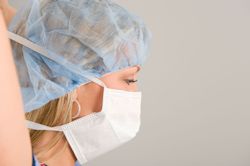Personal Protective Equipment (PPE)
Using PPE
Personal protective equipment (PPE) is specialized clothing or equipment that is used in conjunction with other control strategies to protect you from exposure to blood or other potentially infectious material (OPIM).

Personal protective equipment is designed to keep blood and other potentially infectious material away from your skin, eyes, and mouth.
Below are examples of using PPE to prevent exposure to bloodborne pathogens.
- Gloves: Healthcare workers and others who may come into contact with blood or other bodily fluids should wear gloves to prevent exposure. Gloves should be changed between patients or when torn or punctured.
- Masks: Masks can protect the nose and mouth from exposure to respiratory droplets that may contain bloodborne pathogens. They are particularly important in situations where splashes or sprays of bodily fluids may occur, such as during surgery or other medical procedures.
- Gowns: Gowns provide full body protection and can prevent blood or other bodily fluids from coming into contact with skin or clothing. They should be used in situations where splashes or sprays are likely, such as during surgeries or other medical procedures.
- Eye Protection: Eye protection such as goggles or face shields can protect the eyes from splashes or sprays of bodily fluids that may contain bloodborne pathogens.
- Respirators: Respirators are used in situations where there is a risk of airborne transmission of bloodborne pathogens, such as during aerosol-generating medical procedures or in laboratories.
- Boots or Shoe Covers: Boots or shoe covers can prevent exposure to blood or other bodily fluids that may be on the floor or ground.
Knowledge Check Choose the best answer for the question.
7-1. Which hazard control strategy is used in conjunction with other strategies to help to prevent skin contact with bloodborne pathogens?
You forgot to answer the question!
